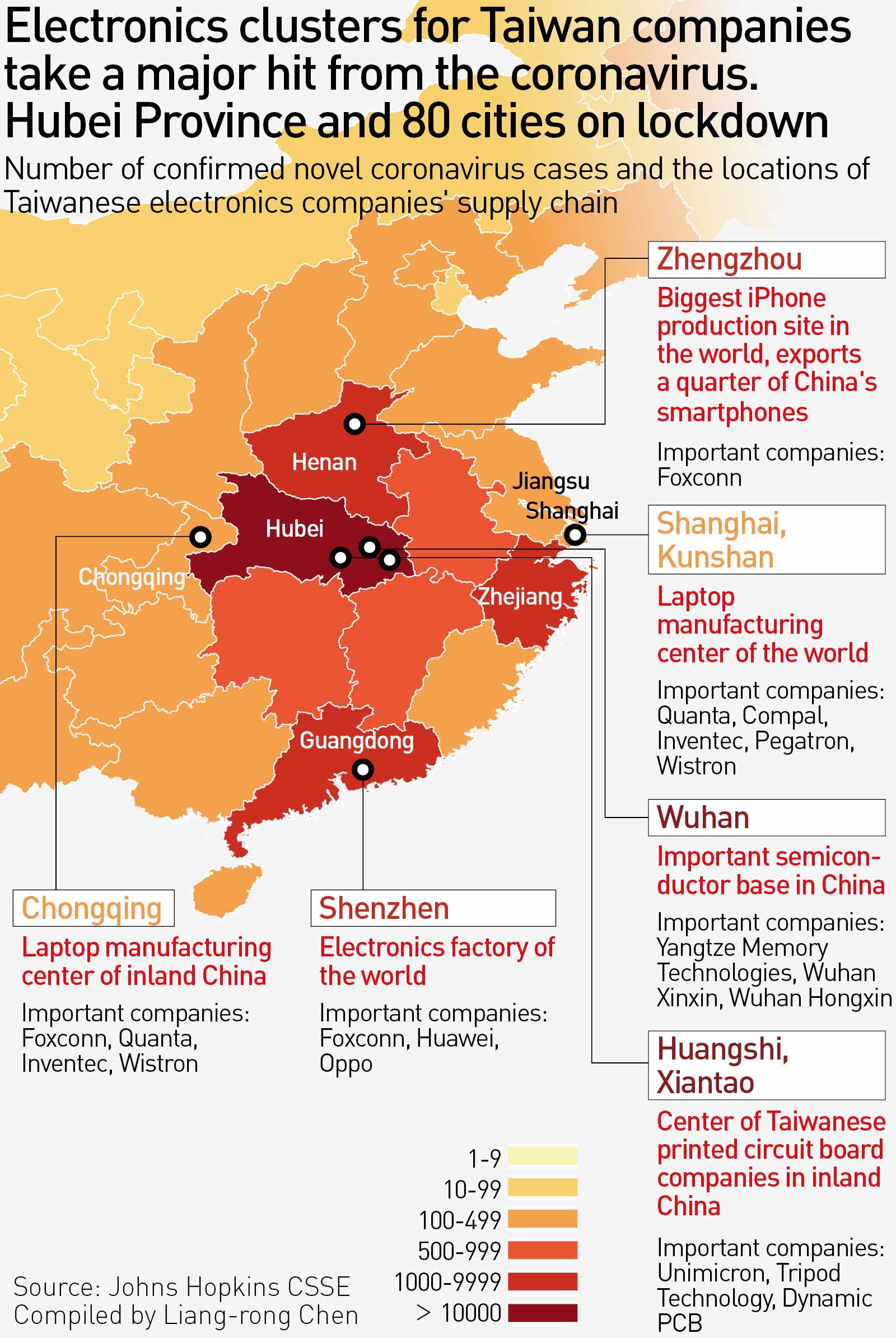Coronavirus to Take Bite out of GDP - Can Taiwanese Companies Cope?

Source:Kuo-Tai Liu
Optimism for 2020 has been seriously dampened by the arrival of the novel coronavirus epidemic. CommonWealth reporters talked to top Taiwanese businesses to find out how it will affect Taiwan’s economy and how they are responding.
Views
Coronavirus to Take Bite out of GDP - Can Taiwanese Companies Cope?
By Kuo-chen Lu, Yi-chih Wang, Laura Kang, Kwangyin Liu, Ching Fang Wu, Li Hsun Tsai, and Rebecca LinFrom CommonWealth Magazine (vol. 691 )
When the United States and China signed a phase-one trade deal in mid-January, Taiwanese companies were ecstatic, expecting boom times to be on the way. Those dreams were dashed just two weeks later with the outbreak of the novel coronavirus in Wuhan in late January.
The coronavirus could ravage some industries in Taiwan far beyond the damage done in 2003, when the SARS scare stalled the local economy for months. What kind of blow are Taiwanese companies, from manufacturers to tourism operators, likely to face and what can they do about it?
Petrochemicals: Likely to Face Biggest Blow
The petrochemical industry represents Taiwan’s second biggest source of exports and is the export sector most dependent on China. The Formosa Plastics Group has forecast that the coronavirus scare will hit it far harder than did the SARS crisis in 2003, with first quarter revenues, which were originally expected to take a turn for the better, likely to slump from the previous quarter.
That’s because Formosa Plastics is more dependent on China than it was 17 years ago, when it had yet to build its petrochemical complex in Ningbo in Zhejiang province, and because of China’s profound economic change.
 Photo by Chien-Ying Chiu/CW
Photo by Chien-Ying Chiu/CW
China’s economy accounted for only 4.3 percent of global GDP in 2003 but 16.3 percent of global GDP in 2019, and the bigger the economy, the greater the demand for basic raw materials. Half of the Formosa Plastics Group’s output of plastic materials is sold to China, but the epidemic could take a huge bite out of demand.
Based on what Formosa Plastics, Nan Ya Plastics and Formosa Chemicals & Fibre are hearing firsthand, Chinese customers have yet to start work after the extended Lunar New Year holiday or prepare raw materials, and the transportation situation remains a huge unknown. In other words, the epidemic has prevented China from going back to work, and if plastic materials are not being used, they will turn into inventory.
So what can be done? “There are no products that can’t be sold. There are only prices at which products cannot be sold,” says Formosa Petrochemical Corp. President Tsao Minh.
 Source: Formosa Nan Ya Plastics
Source: Formosa Nan Ya Plastics
If China shuts down for an extended period of time and inventories build up, “under the worst case scenario, the crack spread [the difference in price between a refined product and crude oil] would fall below US$2, and we would cut production, which would mean we were producing below cost,” Tsao said.

Car Industry: Second Biggest Loser
The automotive sector is also staring at a potential tsunami. Hubei province, the epicenter of the coronavirus outbreak, is one of China’s four main automotive manufacturing hubs, and its annual output of nearly 2.5 million vehicles accounts for 8.8 percent of China’s total production. Aspiring to become the Detroit of China, the Hubei capital of Wuhan is home to many big brands such as SAIC General Motors Corporation and Dongfeng Honda Automobile Co. and a supply chain consisting of more than 500 automotive components companies.
The quarantine of Wuhan will inevitably deal car companies sizable losses. A Chinese research organization has estimated that car sales by volume will fall 30-35 percent in the first quarter and roughly 3-6 percent for 2020 as a whole from a year earlier. The industry will likely feel the impact of the coronavirus for at least three to six months, the group said.
An executive at a car company was even more pessimistic, projecting at least a 50 percent drop in first quarter sales compared to the same period a year ago, a far more dramatic slump than during the SARS scare.
“At that point, China was buying about 2 million to 3 million cars a year, but now the market is 20 million to 30 million cars a year. So the shock will be at least 10 times worse,” the executive said.
Production and sales will both be ravaged. Components made in Wuhan cannot be shipped out, and car sales will likely be dismal, as showrooms stay closed in the many Chinese cities that have been sealed off to contain the highly contagious virus.
James Hsiao, an analyst with the Industrial Economics and Knowledge Center at the Industrial Technology Research Institute, said China accounts for about 5 percent of Taiwan’s automotive parts exports, and that could fall to zero in the worst-case scenario.
 Photo by Kuo-Tai Liu/CW
Photo by Kuo-Tai Liu/CW
Tradetool Auto Co., a overseas Taiwanese company that supplies parts for electric vehicles to China, expects to feel the pinch. Its general manager, Chang Ming-hung, said 70 percent of Tradetool’s revenue comes from China, and he expected the company’s production to be affected for at least three to six months.
Companies with production hubs in Taiwan and markets primarily in the United States and Europe will be much less affected, including Hota Industrial Manufacturing Co., a company in the Tesla supply chain. Hota Chairman David Shen said that while Tesla may now be selling cars in China, all of its vehicles are still assembled in the United States, and therefore the epidemic should not present manufacturing problems.
Steel Industry: Stable Supply Chain
Another important producer of basic materials, the steel industry, is better positioned than the petrochemical sector to absorb the epidemic’s blow. China Steel Executive Vice President Hwang Chien-chih said the company’s raw material supply chain will not be interrupted because those materials are sourced from Australia, Brazil or Canada.
 Source: China Steel
Source: China Steel
As for other items used in the production process, some are purchased from China but all of them have substitutes, Hwang said, confident that the epidemic will not hurt production.
On the demand side, Hwang said China is currently postponing or decreasing its orders, and demand for February and March will likely remain slow. Over the longer term, however, China’s government has pledged to keep economic growth above 6 percent in its bid to achieve a “moderately prosperous society,” and Hwang felt that once the epidemic has passed, Beijing will take steps to stimulate the economy. With that in mind, he suggested factories there could accelerate the pace of production as soon as March or April, rekindling demand.
Machinery and Machine Tool Sector: Diversified Market, Rebound Expected
China Steel’s exposure is also limited because its customers generally sell only a small portion of their production to China, and the U.S.-China trade war further eroded sales of machine tools to that market, Hwang said.
Hiwin Technologies Corp. Chairman Eddie Chuo said it was still hard to assess the impact of the epidemic because many of the motion control and system specialist’s customers in China had yet to return to work following the holiday. Because of the trade war, however, Hiwin pushed to diversify its markets and has seen good growth in Europe, Chuo said. He also anticipated that as the coronavirus scare eases, urgent orders will come in and felt Hiwin needed to start preparing for the potential surge now.
Textiles: Well-positioned but Plenty of Risks
Taiwan’s textile industry was once highly dependent on China’s population dividend, but companies have since diversified their customer bases and spread out their production hubs. That has made it more of a winner than a loser from the epidemic, but hidden risks abound.
Chen Yu-lung, general manager of the Weaving & Dyeing Department of Tuntex Incorporation, said he expected China’s demand for textiles and fabrics would be revised lower in the next month or two, forcing a cut in production.
 Photo by Chien-Ying Chiu/CW
Photo by Chien-Ying Chiu/CW
China, he said, remains the world’s biggest garment exporter, with more than a 30 percent share of the market, but the reopening of apparel factories could still be a long way off, which would inevitably deal a blow to the global garment sector. A majority of Taiwanese clothing makers have moved their manufacturing out of China, Chen said, and he predicted the exodus would be accelerated by the epidemic.
Ling Heng-yu, spokesperson for leading Taiwan garment processor Makalot Industrial Co., said 96 percent of the company’s production is outside of China, so even if its plants there do not reopen on schedule, it can compensate for the shortfall with capacity from other countries.
As for the apparel market, the United States accounts for 70 percent of Makalot’s sales, and its U.S. customers have not only not cut orders since the onset of the epidemic, some have increased them because forecasts of demand for the U.S. this year are higher than previously anticipated.
One potential issue for Makalot is its use of Chinese managers at its overseas plants. Some of those Chinese employees went home for the vacation and may now be stuck there because of the epidemic, unable to return to their workplaces in Vietnam. Even if they could return to Vietnam, they would be quarantined for 14 days before they could step back into Makalot factories. Even worse would be a delay in getting back to work or see serious port congestion.
Tourism: Belt-tightening Time
Taiwan’s tourism sector was already reeling late last year when China blocked its citizens from traveling to Taiwan independent of tour groups, and the coronavirus epidemic has sharpened the blow, though perhaps not in the way one might have imagined.
“Preventing Chinese people from entering [Taiwan] will not affect us that much,” admitted Phoenix Tours International Chairman Chang Wei-yao. The real problem, he said, is the lack of interest among Taiwanese consumers in going abroad. Almost all group tours for which people have paid deposits have been postponed and new orders have not been coming in. “People are not even up for going out to eat, much less dragging their suitcases to go get on a plane,” he said.
Many travel agencies have decided to take six-month breaks, but Chang is not planning on putting staff on unpaid leave. He expects that with the support of Taiwan’s government, the situation will not be as serious as during the SARS scare.
 Photo by Ming-Tang Huang/CW
Photo by Ming-Tang Huang/CW
If, however, the epidemic takes a sharp turn for the worse, Chang would not rule out using the same strategies seen during the SARS slowdown – encouraging employees to take unpaid leave or even cutting salaries and waiting for business to improve before making it up to them.
Hotels find themselves in an equally precarious position. The Landis Hospitality Group said that from the Lunar New Year holiday to the present, it has been deluged with room and restaurant cancellations.
The Worst Could Be Yet to Come
Domestic demand has not been as badly battered by the coronavirus scare as the tourism sector, but that could change, as Jeff Lee, the senior vice president of operations of restaurant company Bayshore Pacific Hospitality, has found out.
 Photo by Liao, You-Qiang
Photo by Liao, You-Qiang
Lee, whose company counts TGI Fridays Taiwan and Texas Roadhouse Taiwan among its brands, said business on Lunar New Year’s Eve (Jan. 24) was excellent and take-outs of New Year’s Eve feasts set a record high. But revenues began to plummet after Jan. 27, and “sales on the weekend were even down 50 percent,” making him realize how serious the situation could get. To date, revenues are down 20-30 percent, Lee said, and he warned that the worst may still be to come.
Lee recalls that in May 2003 during the SARS scare, his company’s revenues plunged 80 percent year-on-year, and he has already revised downwards his sales projection for the coming three months. The company is also adjusting work shifts to save manpower and could encourage employees to take vacation, and it has decided to push the outside delivery business harder to boost revenues, he said.
According to National Development Council (NDC) estimates, the coronavirus epidemic will lower Taiwan’s full-year economic growth by 0.3-0.71 percent, but its impact will continue to be monitored.
The situation may not be so dire, however.
“Right now, all of our projections are based on the SARS outbreak in 2003,” said NDC chief Chen Mei-ling, but many of the economic models that exist today were not around 17 years ago.
From e-commerce and home delivery platforms to the rise of immersion travel, many new forms of commercial activity exist today that could remove some of the sting from the coronavirus scare and even generate new opportunities.
Have you read?
♦ Desperation in Wuhan
♦ Apple Supply Chain Disrupted by Novel Coronavirus
♦ Coronavirus Outbreak is a Disaster of China's Nationalism: Academia Sinica Scholar
Translated by Luke Sabatier












